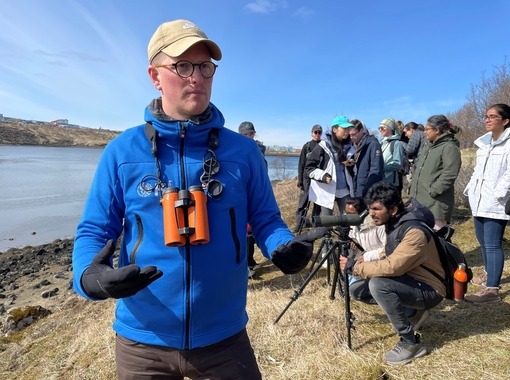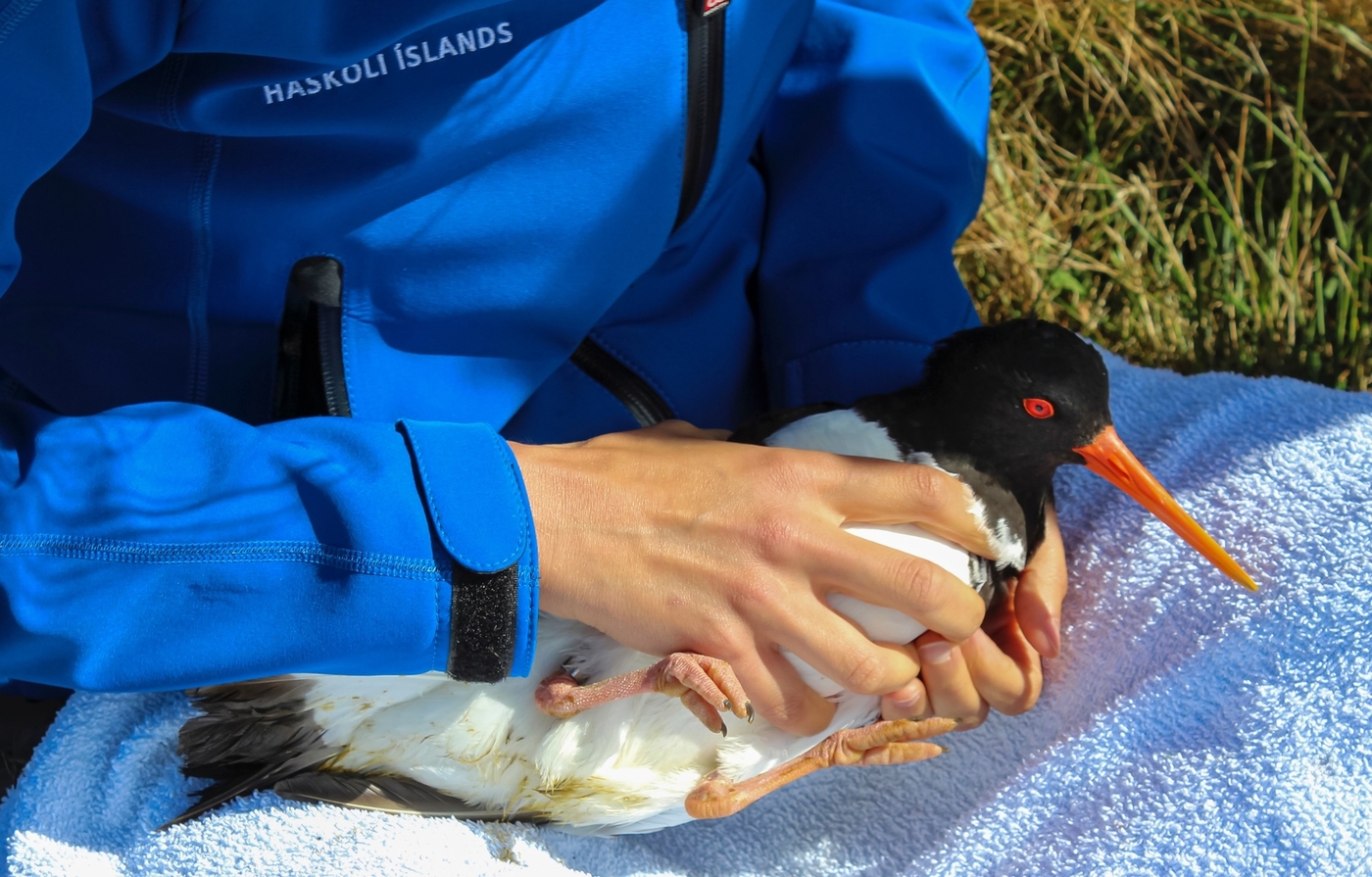The oystercatcher is a common sight in Iceland, instantly recognisable with its striking black and white plumage, its long, orange beak, and its long, orange legs.
"Icelandic oystercatchers are most often found in one of two habitats during the summer breeding season. Some birds prefer to remain close to the shore and the beaches, where they mainly feed on mussels, cockles, lugworms and other intertidal invertebrates. The rest of the population seeks out farmland and moors further inland, particularly in South Iceland, where they feed on worms and insects," explains Sölvi Rúnar Vignisson, whose PhD project is all about oystercatchers. His research looks at the migratory behaviour of the birds and how this behaviour affects their demography. Sölvi Rúnar has worked as an ecologist at the Suðurnes Science and Learning Centre since 2013. Most of his research there has focused on birds or coastal environments.

The project chose the scientist
Sölvi says that this project really chose him, rather than the other way round. "There is a very strong team of bird researchers at the UI Research Centre in South Iceland, who have been looking at oystercatchers since 2013. The oystercatcher is a typical Suðurnes species and, naturally, I got involved in the project. I started tagging oystercatchers in 2016 and as time went on, I began to notice interesting patterns. I then organised a public outreach project on oystercatchers, with Suðurnes school children actively involved in the research. The next logical step was to continue this work and I contacted Tómas Grétar Gunnarsson to ask whether his team at Laugarvatn had room for a PhD student."
And it did. Tómas Grétar, director of the UI Research Centre at Laugarvatn, is now Sölvi Rúnar's main supervisor for his oystercatcher research project. Another of his supervisors is Veronika Mendez Aragon, a research specialist at UI who has spent many years investigating oystercatchers in partnership with the UI Research Centre in South Iceland. The others are José Alves, visiting research scientist at UI, Jennifer A. Gill, senior lecturer at the University of East Anglia, and Jörundur Svavarsson, professor emeritus in marine biology at UI.
"I did my bachelor's thesis at the University of Iceland, which focused on birds, as well as a Master's project looking at how wading species stop to feed along the Icelandic coastline before continuing to their nesting sites in Greenland and Canada," explains Sölvi Rúnar. Examples of such species including the sanderling, the turnstone, the knot and some of the ringed plovers and dunlins that visit Iceland each year.
A third of the oystercatcher population remains in Iceland all year round
The oystercatcher has a connection to the weather in Icelandic superstition. If one settles in a field making its loud and distinctive calls, it's believed to be a sure sign that rain is on the way. Although the oystercatcher is classed as a migratory bird, some of the population remain in Iceland throughout the year.
"They exhibit partial migration, which means that part of the population migrates while the other part remains. In populations like that, we can assume that their circumstances are similar during the breeding season, but that they differ in their migratory behaviour. This makes for interesting comparisons. For example, if conditions in the wintering grounds of the resident birds improve along with rising temperatures caused by climate change, the cost of migrating could become very significant when it comes to competition between individuals at nesting locations," says Sölvi Rúnar.
We know that around a third of Icelandic oystercatchers are resident in Iceland throughout the winter, while the rest migrate to Western Europe. The oystercatcher is unusual among wading species, because it continues to feed its young far into the autumn and even into the winter. Parents feeding chicks as big as them can be a very peculiar sight. The other unusual thing about oystercatcher chicks is that they can swim, unlike their parents, and can use this ability to escape predators.
"Changes to the migratory behaviour of birds are very helpful in this regard. They help us to clearly see and measure the impact of climate change. Oystercatchers spend most of the year on the shoreline. Their main sources of food are crustaceans and other intertidal invertebrates. These invertebrates are very sensitive to ocean acidification and if their populations begin to decline, it will be devastating for Icelandic wading birds," says Sölvi Rúnar Vignisson who is telling people about migratory birds in the annual tour Hiking Trips with Science Tips. image/Jón Örn Guðbjartsson.

Important research that could have a wide-reaching impact
Sölvi Rúnar has no doubt that his oystercatcher research could have a wide-reaching impact. "First of all, there have not been many studies on the Icelandic oystercatcher population. Secondly, most Icelandic birds are migratory and with a warming climate, it is likely that we will see more birds staying over the winter. These are changes that could have a huge impact on ecosystems in Iceland, so it is vital that we monitor and research any developments."
The main findings so far have resulted in an updated map of the distribution of oystercatchers, both in Iceland and abroad, and a better understanding of how certain nesting locations are linked to certain wintering grounds. "The clearest example is that birds that nest in the West Fjords are much more likely to be resident over the winter, while birds in South Iceland are much more likely to be migratory. The distance from decent wintering grounds in Iceland seems to affect their choice to migrate or not. The next questions the study will try to answer have to do with the separation frequency of breeding pairs, in the context of migratory behaviour." By this, Sölvi Rúnar means the question of whether migratory behaviour affects whether an oystercatcher finds a new mate. Generally, the oystercatcher is monogamous and will remain loyal to a mate to a certain extent.

Protecting biodiversity is essential
The University of Iceland prioritises the UN Sustainable Development Goals in its overall strategy and this research is relevant to the SDGs in various ways. The study is about identifying and understanding changes to our climate. To understand these changes, we need to be able to observe them and analyse their impact.
"Changes to the migratory behaviour of birds are very helpful in this regard. They help us to clearly see and measure the impact of climate change. Oystercatchers spend most of the year on the shoreline. Their main sources of food are crustaceans and other intertidal invertebrates. These invertebrates are very sensitive to ocean acidification and if their populations begin to decline, it will be devastating for Icelandic wading birds. Oystercatchers are waders that favour open landscapes and rich summer feeding grounds for their chicks. Like most waders, oystercatchers avoid nesting in or near wooded areas. Waders are a huge part of the birdlife in Iceland. This means that Iceland's goal of protecting biodiversity is at odds with the goal of capturing carbon through re-forestation efforts."
Sölvi Rúnar argues that the best way to increase biodiversity and capture carbon is to increase the amount of Icelandic wetland, for example by filling in drainage ditches, as well as protecting the countryside from over-grazing and holiday home construction. "We need to consider essential nesting sites for oystercatchers and birds in general and indeed the entire ecosystem before we embark upon building things like new roads, bridges or wind turbines."




